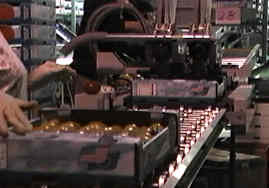 Marketing
Marketing Marketing
Marketing It
is imperative that good markets be identified before any
investments are made in hydroponic tomato production. The fruit
are of high value and perishable. Once harvested the tomato fruit
continues to ripen, this process can be delayed only slightly
with refrigeration. Disastrous quality losses can occur at any
stage in the marketing chain from grower to consumer and the
total value of the product may be lost. Every activity in the
production and marketing chain must be precisely timed.
It
is imperative that good markets be identified before any
investments are made in hydroponic tomato production. The fruit
are of high value and perishable. Once harvested the tomato fruit
continues to ripen, this process can be delayed only slightly
with refrigeration. Disastrous quality losses can occur at any
stage in the marketing chain from grower to consumer and the
total value of the product may be lost. Every activity in the
production and marketing chain must be precisely timed.
The highest prices for hydroponic tomatoes are during the winter, when there is little or no production of open field tomatoes in the United States. Imports from Europe and Israel present some competition but do not have the taste and quality of greenhouse hydroponic tomatoes produced in high light desert regions of the southwestern part of the United States.
In the spring, fruit from Mexico and Florida will decrease the wholesale prices received for hydroponic tomatoes, but the hydroponic fruit will still bring two to three times higher wholesale prices.
 The
distribution if hydroponic tomatoes is throughout North America.
The major mode of transportation is by truck. In the future when
markets open in the Pacific Rim countries, the tomatoes will be
shipped to various regions of the world by air. Typically
packaged in 15 pound boxes, each with fruit of even size and
color. Premium prices are paid for jumbo fruit weighing 225 grams
or more.
The
distribution if hydroponic tomatoes is throughout North America.
The major mode of transportation is by truck. In the future when
markets open in the Pacific Rim countries, the tomatoes will be
shipped to various regions of the world by air. Typically
packaged in 15 pound boxes, each with fruit of even size and
color. Premium prices are paid for jumbo fruit weighing 225 grams
or more.
Hydroponic tomatoes are handled by most major grocery stores today and are becoming increasingly popular due to their high quality and flavor. As a result, there is a rapid increase in construction of greenhouse hydroponic tomato facilities in the desert southwest, where growers from Holland, England and the United States are rapidly building an exciting new agricultural industry.